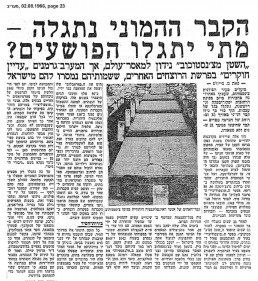The ŻOB Bunker Victims' Grave
by WIESŁAW PASZKOWSKI, Częstochowa Municipal Museum, History Documentation Centre
Edited: ALON GOLDMAN, Chairman of the Association of Częstochowa Jews in Israel English translation: ANDREW RAJCHER
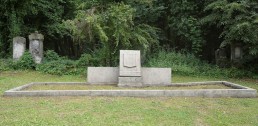
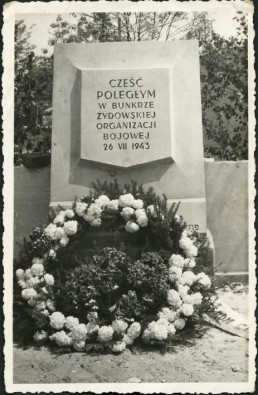
The lack and, to a greater extent, the inaccuracies of journalistic information condemn us to the making of assumptions. A fundamental error in the date on the tombstone creates an additional difficulty.
The most important factor in the identification of the remains is the place in which they were found – at the exit of ul. Nadrzeczna, next to former house numbers 86, 88 and 90. From the end of October 1942, it was within the terrain of the Stare Miasto (Old Town), which was the forced labour camp for Jews, the so-called “Small Ghetto”. From that time, the Germans brought Jews here – those who still remained alive following the transportations to Treblinka and the mass murders in the Częstochowa ghetto. The camp was surrounded by concrete posts and interwoven barbed wire. It was located on the outside of the Rynek Warszawski which served as an assembly point. Entry into the “Small Ghetto” was possible through the so-called wylot (outlet). There was no gate here, just a wooden birch barricade and barbed wire, which was put in place and moved aside when necessary.
The Rynek Warszawski, a large square once used for market fairs, is now completely empty. The square was adjacent to ul. Garncarska and ul. Jaskrowska. This is where the future labour camp was to be located, with concrete poles stuck into the ground, linked with dense coils of barbed wire. Attached to them were moveable wooden trestles. When these were moved aside, a space was created through which a vehicle could be driven. The same concrete posts and barbed wire could be found along ul. Nadrzeczna.
The building at Nadrzeczna 88 was taken over by Möbellager workers. Soon, probably in the basements, they organised hiding-places into which they could smuggle the elderly, the women and the children, who could no longer be kept in the Möbellager itself. Later, this building and the one next to it were taken over by the Żydowska Organizacja Bojowa (ŻOB) which was formed late in 1942 (and which also contained workers from the Möbellager). ŻOB’s aim was to resist the Germans in the event of any attempt by them to liquidate the “Small Ghetto”. The issue of escape from the “Small Ghetto” was considered and, to this end, tunnels were drilled which led out of the camp. The entrance to one of the tunnels was located at the house at Nadrzeczna 88, which also served as ŻOB’s main arsenal. Because producing firearms inside the ghetto proved to be too difficult, firearms were acquired either through buying or stealing them. In the main, hand grenades were produced. These weapons were stored in the warehouse.
That the Jews were armed and ready to use them was a fact that the Germans should have realised on 4th January 1943, following the actions of Mendel Fiszlewicz and Icchak Feiner. Hauptmann Degenhardt handed oversight of the “Small Ghetto” to the Überschärr, who were slavishly obedient and brutal, but too primitive. This happened after March or even in May 1943. The first known effect of this change was the operation against Macheł Birencwajg on 8th June 1943.
The regime in the ghetto had become more severe. The newly appointed camp commandants were Schutzpolizei political affairs specialists Kestner and Laschinski, who were fluent in Polish and, thanks to that, were well-versed in the life of the ghetto. It became clear that their task was to uncover the ŻOB structure. The partisans intensified their vigilance. Assemblies of specific groups were ordered more frequently and those Jews who were connected with the two Lagerführers were watched closely.
ŻOB intercepted correspondence from Rozenberg, a Jewish policeman, to the Gestapo and, on 21st June 1943, they killed him – but it was too late. The Germans already knew the sites of the hiding-places and the tunnels. They knew a great deal about ŻOB’s activities. The organisation had used a hired truck to send arms to a group in the forest. The German driver notified the police. The vehicle was stopped by the Gestapo. In the shooting that followed, Pinek Samsonowicz was killed, Lolek Blank fled, while Harry Potasiewicz fell into the hands of the Gestapo. The Germans tortured Harry in the window of the Jewish Police building and ordered the entire populace of the ghetto to walk past it. He betrayed no one and died on the way to the place of execution.
The Germans attacked the “Small Ghetto” in the evening of 25th June 1943. They countered the vigilance of the partisans by sending in small groups of workers, which was to mimic the normal return of the day shift. When the alarm was cancelled, the partisans left their hiding-places and returned their arms to the arsenal. It was then that police cars entered the camp grounds. They first attacked the bunkers at Nadrzeczna 86 and 88, where Commandant Mojtek Zylberberg was located. Almost everyone in the hiding-places was killed. Mojtek, who was wounded, committed suicide. Now, the Germans began shooting at everyone on the streets. The liquidation of the “Small Ghetto”, the selections and the transports to be shot lasted into the following day. Many people were still in hiding in the houses, basements and attics. Some were lured out when Degenhardt announced an “amnesty”. (After three days, he ordered all those who had been “amnestied” to be shot.) However, in July, the camp was still being liquidated, with buildings being burned or blown up.
There would have been around 1,500 victims of the “Small Ghetto” liquidation. Why, then, have the remains of only a dozen or so dead been honoured? After all, the tombstone has the form of a monument. Częstochowa Jews probably thought that they were paying tribute to the bravest fighters of the “Small Ghetto”. Perhaps the body of ŻOB Commander Mojtek Zylberberg is also in this grave.
Rivka Glantz


Moitek Zilberberg
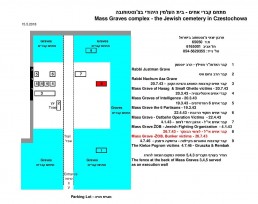
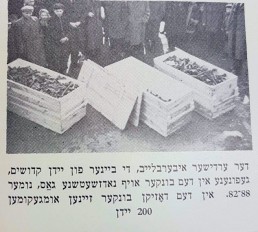
Above: Translation from Yiddish: Remnants of the bones of holy Jews, found in a bunker at ul. Nadrzeczna 82-88 , in which 200 Jews were murdered
Below: An article on finding bones on the street in August 1966
